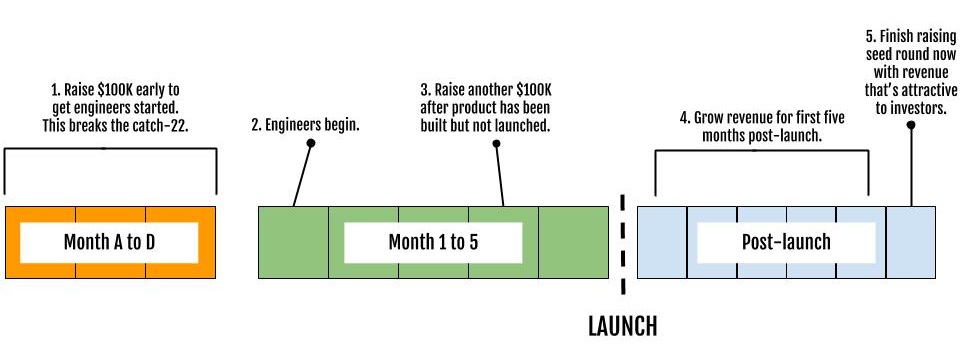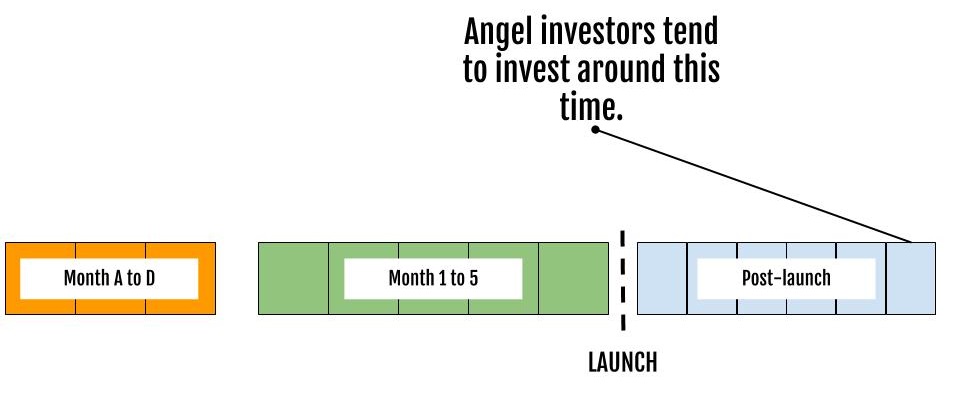Raising Capital: My Method of Breaking a Pesky Catch-22
From quickly scanning through the top search results on raising capital, I noticed there’s a general consensus: it’s a necessary evil that can’t be ignored.
You need to raise capital to run your business, but will anybody see the value in what you’re offering? Already, you’re asking the wrong question…
A common interaction: an angel investor says to the upteenth first-time founder, “Come back post-revenue.”
You’re hearing it or have heard it. I know I definitely heard that early on.
This may seem obvious, but bear with me. Investors can probably see the use of what you’re offering. You probably wouldn’t have gotten the meeting, otherwise. But that doesn’t mean you’ve demonstrated your product or service’s value.
Are you building a customer base? Do you have a business plan? A founder team established?
This is all predicated on your having launched your product/service.
But you need to start raising capital to start seriously building your product. But you need a product to start acquiring capital.
A pesky catch-22.
Fear not, I’ll walk you through my method on how to raise capital to eliminate this supposed blocker.
| REMEMBER | Even though I’ve been in the startup space for over a decade, I am just one person of many. My blog can never replace the advice of an expert who knows the particulars of your startup. Always seek out second, third, fourth opinions from experts who truly care about you and your business. |
Side note: Check out my article ‘A look at the Techstars Seed Accelerator Program’ to learn about a possible source of funding. If you’re in or thinking about building a B2B SaaS startup, take a look at ‘A few tips on how to survive as a B2B SaaS Startup.’
Breaking the Catch-22 of Raising Capital
You might think you need to be immediately raising as much capital as possible. There’s some level of security in that, perhaps. The chances of leapfrogging the seed round to start your series A funding is slim. Also, you suddenly become beholden to a major investor, who has their own agenda (receiving the best ROI)
So, onto the million (or billion) dollar question: how do you even reach the point where most angel investors are willing to invest?
| Raise only a small portion of your seed round, so you have enough capital to build and launch your product. |
Usually, a seed round amounts to $800K – $1.5M, but you can’t expect an idea alone to raise the kind of capital you need.
Again, you need to develop your product/service ASAP.
This is a timeline I’ve drafted to help you visualize what I’ll be talking about:
What has generally worked for me is to first raise $100K. With that money, I can assemble an engineering team to start building the product. You should also use this time to establish your founder team and fine-tune your product vision/direction. Getting these matters ironed out now will better your chances of acquiring investors later on your terms.
| FURTHER READING | ↪ What I (A Startup CTO) Look For In A Non-Technical Cofounder |
A month or two before launch, you should start trying to raise another $100K to sustain you until you start seeking out angel investors. You’ll have your product built, which will definitely help persuade people to give you capital. 
~5 months+ post-launch, that’s when angel investors want to invest. If you’re on the right track, you should be around $15K/month in revenue by this point.
Target Investors & How to Find Them
“Alright, alright, that all sounds good, but how do I go about raising capital?”
Of course, the investor needs to have enough funds to give you money. I think this goes without saying, but you shouldn’t be targeting your younger sibling who’s eating instant noodles every day at college. They might be a good candidate to challenge your ideas and/or test your product out. That’s it, though. Unless your sibling’s the next Mark Zuckerberg or something.
With the understanding that you need to find people who actually have the funds to invest in your startup, you should, then, target two specific groups:
- Friends and family
- Experts in the field/industry your product targets and/or individuals who are passionate about finding fixes/innovations for your target industry
For those of you who actively use LinkedIn, you can build a queue of leads by exporting your contact list. Check out who your target investors are linked to. Do they have a connection that you could leverage?
Essentially, this is networking 101.
Something as tenuous as attending the same alma mater as your target investor could be that ‘in’ that gets you the capital you need.
Raising Capital requires…
So you have compiled a (hopefully) long queue of target investors. Should you just email one of them now?
Well, my response is, “Are you prepared?”
I’m not talking about buzz words or hip marketing lingo that’s too vague to mean much. I’m not talking about rousing words that will inspire your investor (although that could help).
| NOTE | To persuade someone to invest, you need to demonstrate how you’re limiting risk. I don’t know how many personal stories I’ve heard about debts and failed investments ruining relationships. Isn’t there a truism advising against going into business with your friends and family? Anyway, money can be a touchy subject. It’s ultimately our means of living. Any person smart enough to have built considerable wealth won’t be so loose with their money. They want as close to a guarantee as possible, a calculated risk. |
When I ask “Are you prepared?” I’m talking about these necessities:
- A stellar pitch deck (10-20 slides presenting the essentials of your startup)
You are providing details about your business and, in the process, yourself. Are you able to cogently articulate the problem you’re trying to fix? Can you communicate how you’re approaching this problem in a unique or particularly effective way?
- Brilliant projected financials
“I can promise you one billion dollars of revenue in a year!” Raising capital would be easy if it were like this, no? Anyone can pull a big figure out of thin air, and it’ll sound good. Investors, however, are putting their money on the line. When you have dedicated time to working out your projected financials, you have evidence that you’ve done your due diligence. They have a clear, detailed plan with the hidden assumptions addressed, making them feel like they know what they’re getting into.
- Letters of Intent
Letters of intent are concrete proof that you’ve got sales, that your real target buyers want your product/service at the price you’ve set. Make sure that the target buyer has not only shown interest but that they have approved the payment for your product/service.
While not as effective as a testimonial where a client praises your startup, letters of intent will be the best you can get at this point. The perceived risk drops considerably when you’ve already got your target buyers saying they’ll pay for your product.
- Video quote
You can take your letter of intent one step further by requesting a video quote from your target buyers. These make for an especially strong ending to your pitch.
Sure, letters of intent are useful and persuasive, but there’s something about a video quote that makes it seem like the target buyer’s really eager to commit to your product/service. Perhaps it’s because the target buyer is willing to get in front of a camera to express their approval…
For your target investor, there’s a visceral experience of seeing a real person (albeit in the virtual flesh) want to do business with your startup. You just can’t get that with a faceless name at the end of a letter.
I’d love to hear from you
What do you think of my method of raising capital? Any things you’d like to add or would do differently?
Since you’re here, I’m looking to partner with serious entrepreneurs who have bold ideas and realistic plans.
First-time founders, I know, find it especially hard to avoid all the pitfalls of building a business from the ground up. My extensive experience as a startup CTO and technical co-founder has given me a lot of wisdom I’d like to offer to you and your startup. From bootstrapping to scaling, I’ve done it all—multiple times over.
If you think you’ve got a game-changing idea, please get in touch!
Bry-13